An Ecological Triptych
click here for the One Rock website created by digital artist Pippa Greenwood
opened by
Peter Hewitt, Chief Executive,
Arts Council England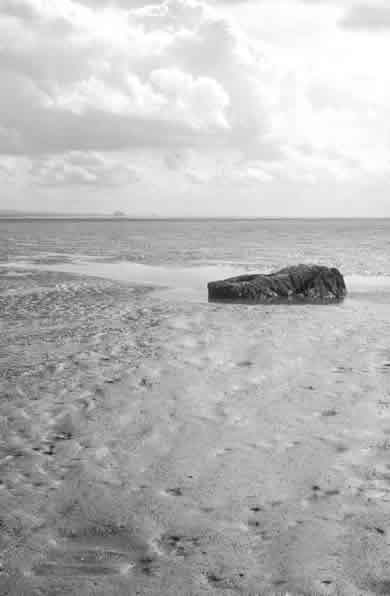
In the North West of England, on the Western shore of Morecambe Bay, a quarter of a kilometre off Bardsea Beach, on the muddy sand between high and low tide marks, there is a lump of conglomerate limestone. Isolated from other rocks on an open expanse of the estuary it stands out as a land marker. It is a favourite point for walkers and their dogs to congregate.
It is an ordinary rock about the size of a mini car. An ordinary rock except that on its humped back is a small inland sea crammed with shrimps, crabs and mussels. In each bucket of sand at its base are a thousand minute sea fleas; in each grain of its body are microscopic shells nurtured in tropical seas; and in each bacterium dancing over its head there are worlds untold.
It is a crouching beast waiting for the next tide in a pool, which is gradually silting up. In its heart ancient tides unfold. It has a tale to tell. It knows of fishermen and drownings, of lighting storms and dance bands on collapsing piers. Its sense of deep time and its local and global perspective could shift our everyday perception.
A group of microbiologists, ecologists, computer scientists, artists
and poets worked together to create a celebratory installation One Rock.
Together they awakened one ordinary rock in the sea between tides in
Winter.
Further Information
The Rock



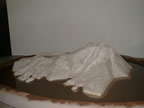
The Rock is limestone, 250 million years old, probably brought to the
Bay as glacial debris. Ten thousand years ago the Bay was a fjord. When
William Wilberforce crossed the sands in 1779 he wrote: "The whole
ride is a most delightful one to Ulverston; you leave the sands three
miles from it. A little before we left them, the Tide was coming in
a yard high at a great distance and the Sun, shining upon it, shewed
like a Range of Diamonds. It has a curious appearance to see large Ships
upon the dry Sand, which are entirely left at low water many miles.
You see on the sands many Rocks, which render the navigation very dangerous."
Local people say the Rock was "above their heads" only forty years ago. Now it is the last big visible rock in the Ulverston side of the Bay and could well disappear under silt in our lifetime.
Microscopic images
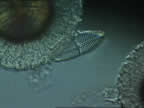


The microscopic images show bacteria, algae, diatoms, minute shells, sand fleas and shrimps, mostly seen at 10,000 magnification. One diatom would therefore in fact be less than a tenth of a millimetre across. Diatoms play a key role in nanotechnology research. All the microscopic material has been gathered from slime and water adjacent to the Rock. The structure of our own bacterial ancestors is mirrored in some of these organisms. This is the kind of soup from which we emerged. Also the spiralling patterns in these minute forms mirror the shapes of colossal distant galaxies.
Bottles
These contain variously, sand, microbes, salt crystals, plants, and other marine life. The sulphurous swampy smell emanates from "Winogradsky Columns", containing a mix of sand, seawater and protein, all exposed to light which is regenerating matter through the activity of millions of microbes (as it does in The Bay). All the sand samples were taken from within a hundred metres of the Rock. If you'd like to make your own, there is an excellent instruction sheet on NASA's website http://quest.arc.nasa.gov A copy of this is also available in our resource room
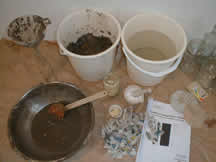 |
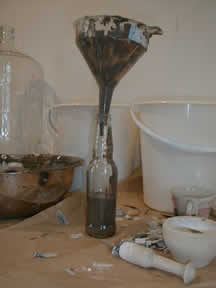 |
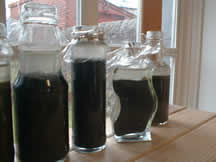 |
Making up the bottles |
||
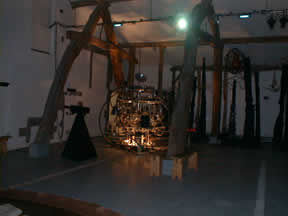

.The bottles in place
Rock Fables
Sun Rock, Song of the Deep, Mutation, Dinosaur's Nativity, Heron's Lament,
Snail Slave Ship, Tree of Knowledge, Mister Punch
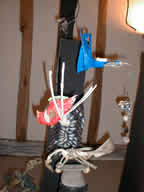
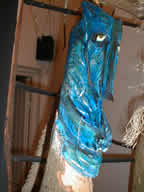
Made from sea-washed bones, these are mostly under the pier and represent
dreams and nightmares, playfully improvised through the theme of an
evolutionary trail, which for humans ends disastrously with a demonic
Mister Punch. We have drawn on the style of shell grottos and visual
nursery rhymes.
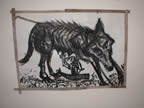
The sea wolves represent both the power of the sea and the last wolf in England which, according to (the usual) local legend, was killed on Humphrey Head across The Bay from Ulverston.
The swinging timber hulk has an uncanny resemblance to a submarine.
Three Microbial Cushions
(in the resource room)
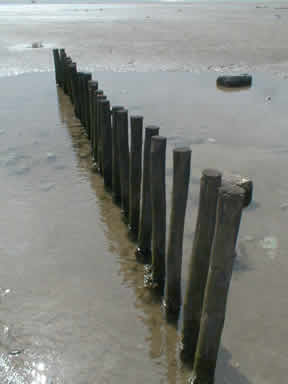 These represent the complex nature of small organisms - 2 are based
on bacteria and the other, on algae. Bacteria can only be seen under
the microscope. Their complex ultra structures, which include plasmid
DNA, ribosomes and cytoplasm, provide the components of a functional
life form. You may have seen algae in action as algal blooms on the
surface of still water.
These represent the complex nature of small organisms - 2 are based
on bacteria and the other, on algae. Bacteria can only be seen under
the microscope. Their complex ultra structures, which include plasmid
DNA, ribosomes and cytoplasm, provide the components of a functional
life form. You may have seen algae in action as algal blooms on the
surface of still water.
The Soundscape
The soundscape is an original composition made from a collage of collected
local sounds, recorded on DAT and minidisc on Bardsea Beach; snippets
of music hall performers who performed around The Bay, archive documentary
recordings from Morecambe's Frontier Land (before it was demolished)
and songs from "The Rock in the Sea Song Cycle" featuring
Andrew Ridal and The Longline Junior Choir.
The sound installation comprises a 5.1 surround system - a front left and right, a rear left and right and a sub-bass behind the video screen. There are also three other sets of speakers mounted at key points in the installation, creating a complete 8-point diffusion system controlled by Logic audio. This allows the sound to travel round the room as well as at the same time having pin-point sound sources.
Telescope
The telescope is an example of Augmented Reality technology. Augmented
Reality is an emerging concept in which various displays and techniques
may be used to create the perceptual illusion that video or graphics
co-exist in and with real environments. In the case of the telescope,
video is fed from a camera housed in the front of the casing through
to a screen which may be viewed through the eyepiece. The video is edited
by passing it through a computer and adding video clips over the camera
view when the telescope is pointing in certain areas. The telescope
is able to measure its own tilt and orientation using an electronic
compass and gravity sensor. It uses the roll of the same sensor, effected
by rotating the eyepiece of the telescope, to zoom the camera view in
or out to uncover the microscopic world of the Rock. Computer science
research has recently started to apply Augmented Reality systems to
overlay such 'invisible' information in a range of domains, including
overlaying historical views in sites of cultural heritage, on-site displays
of future constructions as in town planning, and X-ray machines for
identifying hidden parts of engineering or mechanical structures such
as underground piping and car engines.
Video
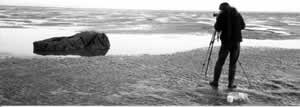
Time lapse and underwater sequences were shot on Sony Mini DV cameras
edited on Adobe Premiere 6.5 systems built with Macromedia Director
7.0.
Resource Room
For more information please refer to our Resource Room on the ground
floor of Lanternhouse where there is an idiosyncratic selection of books,
maps, scientific data, photographs and notebooks, some of which show
the process of creating One Rock.